The AMD Threadripper 2 CPU Review: The 24-Core 2970WX and 12-Core 2920X Tested
by Ian Cutress on October 29, 2018 9:00 AM ESTHEDT Performance: Web and Legacy Tests
While more the focus of low-end and small form factor systems, web-based benchmarks are notoriously difficult to standardize. Modern web browsers are frequently updated, with no recourse to disable those updates, and as such there is difficulty in keeping a common platform. The fast paced nature of browser development means that version numbers (and performance) can change from week to week. Despite this, web tests are often a good measure of user experience: a lot of what most office work is today revolves around web applications, particularly email and office apps, but also interfaces and development environments. Our web tests include some of the industry standard tests, as well as a few popular but older tests.
We have also included our legacy benchmarks in this section, representing a stack of older code for popular benchmarks.
All of our benchmark results can also be found in our benchmark engine, Bench.
WebXPRT 3: Modern Real-World Web Tasks, including AI
The company behind the XPRT test suites, Principled Technologies, has recently released the latest web-test, and rather than attach a year to the name have just called it ‘3’. This latest test (as we started the suite) has built upon and developed the ethos of previous tests: user interaction, office compute, graph generation, list sorting, HTML5, image manipulation, and even goes as far as some AI testing.
For our benchmark, we run the standard test which goes through the benchmark list seven times and provides a final result. We run this standard test four times, and take an average.
Users can access the WebXPRT test at http://principledtechnologies.com/benchmarkxprt/webxprt/
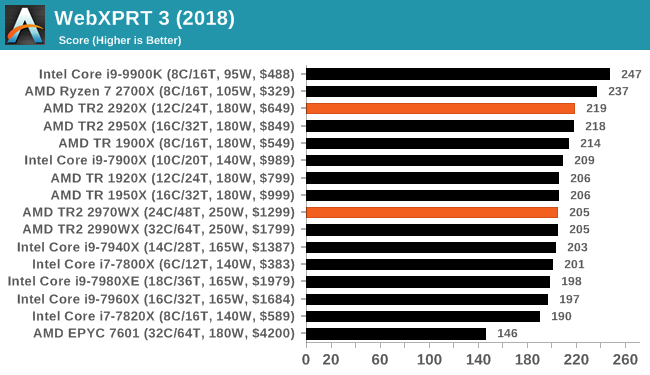
WebXPRT 2015: HTML5 and Javascript Web UX Testing
The older version of WebXPRT is the 2015 edition, which focuses on a slightly different set of web technologies and frameworks that are in use today. This is still a relevant test, especially for users interacting with not-the-latest web applications in the market, of which there are a lot. Web framework development is often very quick but with high turnover, meaning that frameworks are quickly developed, built-upon, used, and then developers move on to the next, and adjusting an application to a new framework is a difficult arduous task, especially with rapid development cycles. This leaves a lot of applications as ‘fixed-in-time’, and relevant to user experience for many years.
Similar to WebXPRT3, the main benchmark is a sectional run repeated seven times, with a final score. We repeat the whole thing four times, and average those final scores.
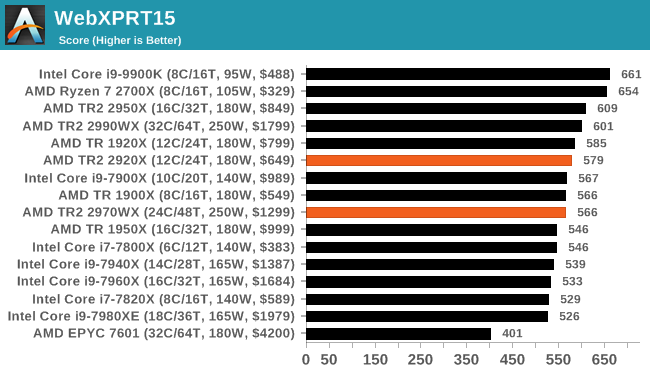
Speedometer 2: JavaScript Frameworks
Our newest web test is Speedometer 2, which is a accrued test over a series of javascript frameworks to do three simple things: built a list, enable each item in the list, and remove the list. All the frameworks implement the same visual cues, but obviously apply them from different coding angles.
Our test goes through the list of frameworks, and produces a final score indicative of ‘rpm’, one of the benchmarks internal metrics. We report this final score.
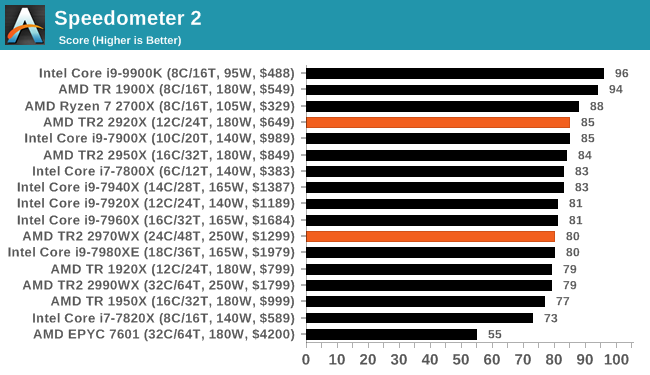
Google Octane 2.0: Core Web Compute
A popular web test for several years, but now no longer being updated, is Octane, developed by Google. Version 2.0 of the test performs the best part of two-dozen compute related tasks, such as regular expressions, cryptography, ray tracing, emulation, and Navier-Stokes physics calculations.
The test gives each sub-test a score and produces a geometric mean of the set as a final result. We run the full benchmark four times, and average the final results.
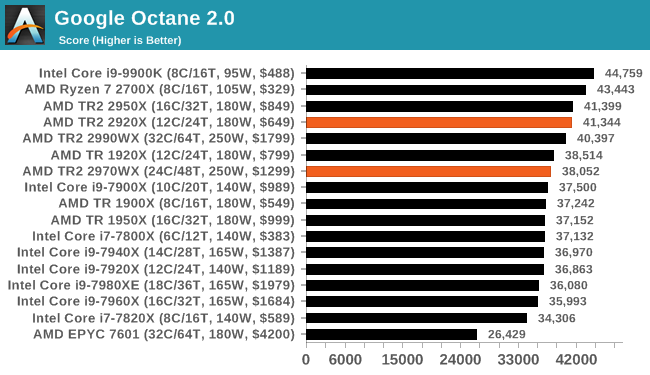
Mozilla Kraken 1.1: Core Web Compute
Even older than Octane is Kraken, this time developed by Mozilla. This is an older test that does similar computational mechanics, such as audio processing or image filtering. Kraken seems to produce a highly variable result depending on the browser version, as it is a test that is keenly optimized for.
The main benchmark runs through each of the sub-tests ten times and produces an average time to completion for each loop, given in milliseconds. We run the full benchmark four times and take an average of the time taken.
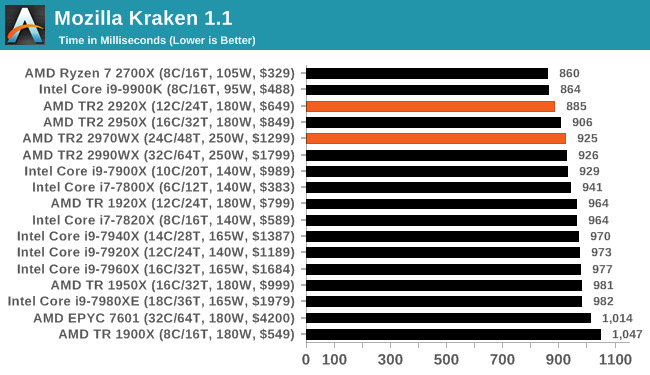
3DPM v1: Naïve Code Variant of 3DPM v2.1
The first legacy test in the suite is the first version of our 3DPM benchmark. This is the ultimate naïve version of the code, as if it was written by scientist with no knowledge of how computer hardware, compilers, or optimization works (which in fact, it was at the start). This represents a large body of scientific simulation out in the wild, where getting the answer is more important than it being fast (getting a result in 4 days is acceptable if it’s correct, rather than sending someone away for a year to learn to code and getting the result in 5 minutes).
In this version, the only real optimization was in the compiler flags (-O2, -fp:fast), compiling it in release mode, and enabling OpenMP in the main compute loops. The loops were not configured for function size, and one of the key slowdowns is false sharing in the cache. It also has long dependency chains based on the random number generation, which leads to relatively poor performance on specific compute microarchitectures.
3DPM v1 can be downloaded with our 3DPM v2 code here: 3DPMv2.1.rar (13.0 MB)
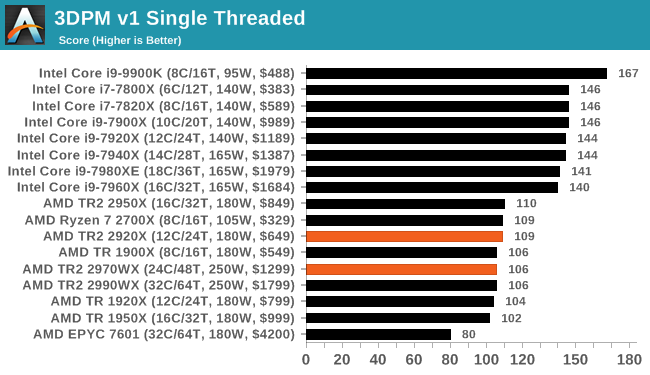
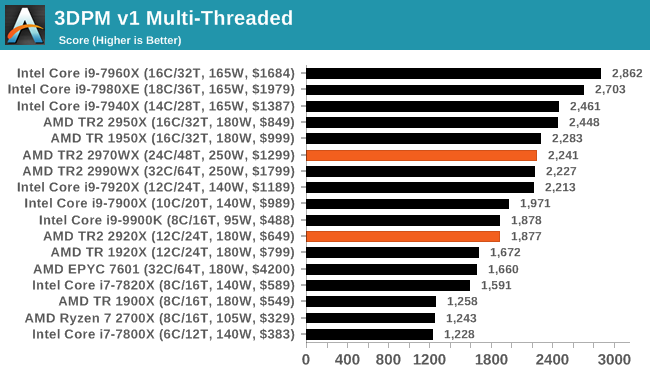
x264 HD 3.0: Older Transcode Test
This transcoding test is super old, and was used by Anand back in the day of Pentium 4 and Athlon II processors. Here a standardized 720p video is transcoded with a two-pass conversion, with the benchmark showing the frames-per-second of each pass. This benchmark is single-threaded, and between some micro-architectures we seem to actually hit an instructions-per-clock wall.
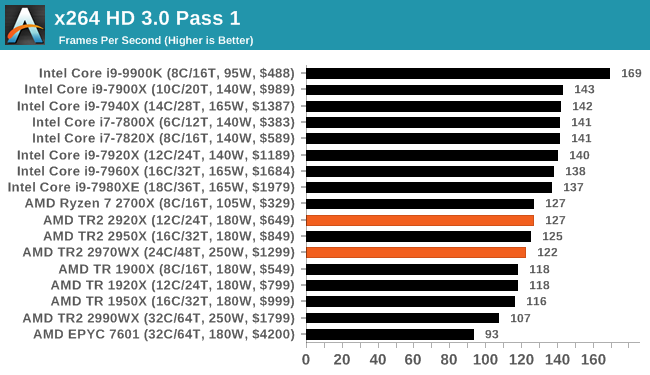
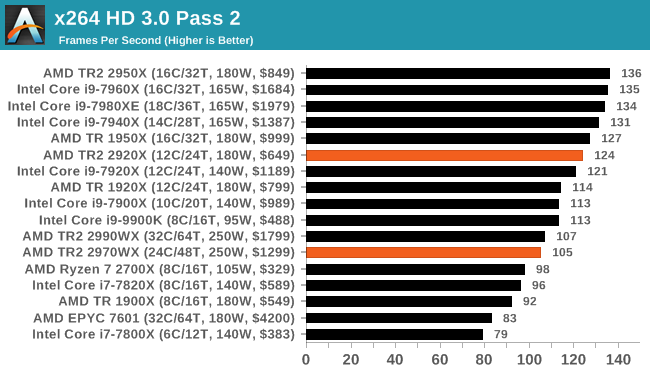










69 Comments
View All Comments
euler007 - Tuesday, October 30, 2018 - link
For gaming a 8600k will beat the 2700x and is priced 16% less than a 2700x (just checked newegg prices).Stuka87 - Monday, October 29, 2018 - link
Hey guys, just a quick correction, World of Tanks has been using the Encore engine for six months now. So its not an unreleased engine. But it is a great engine, incredible performance for the graphics that it offers.Great article otherwise.
br83taylor - Monday, October 29, 2018 - link
Can you clarify if your benchmarks are with PBO enabled or disabled?hoohoo - Monday, October 29, 2018 - link
Civ 6 - the slowest paced strategy game ever, now rendered at high frame rates!hansmuff - Monday, October 29, 2018 - link
Just my personal wish list:Can you make 1080p the new 720p, drop 720p altogether, but add in1440p? I feel that's a pretty common resolution these days, and affordable high-frequency screens with FreeSync and G-SYNC are available. I think it would mean more to people than the mostly artificial 720p.
nevcairiel - Monday, October 29, 2018 - link
720p may not have many real-world usecases anymore, however it does clearly show CPU performance scaling in games while removing most GPU bottlenecks entirely. Its definitely an interesting metric on that alone.mapesdhs - Monday, October 29, 2018 - link
People argue this one a lot; some will say 720p is so unrealistic that what's the point? It shows differences at a resolution that virtually nobody uses, so who cares? Anyone buying this class of hw is far more likely to be gaming at least at 1080p and more likely 1440p or higher. Others say by using a low resolution it allows the test to be used as a psuedo CPU test, but it's hard to escape the criticism that such testing is still not real-world in any useful sense. Interesting from a technical perspective perhaps, but not *useful* when it comes to making a purchasing decision.GreenReaper - Wednesday, October 31, 2018 - link
It helps if you plan to keep the CPU around for when you buy your next video card, which might *then* be CPU-limited when running 1440p. You're basically finding what happens when the CPU is the bottleneck, which it might be in the future. For example, people who upgraded i7-3770K systems with modern video cards. AMD chips of that era (e.g. FX-8370) haven't held up so well.At the same time, if you plan to hand down the system to someone else and get a new one in three year's time, or repurpose it as a home server, the future potential may not matter to you at all.
SLVR - Monday, October 29, 2018 - link
Why no 9900K power consumption figures?mapesdhs - Monday, October 29, 2018 - link
The IR radiation off the chip melted the power meter. ;)